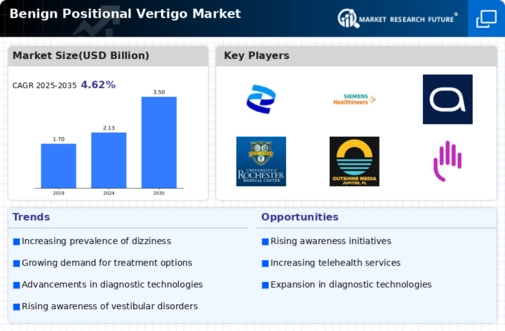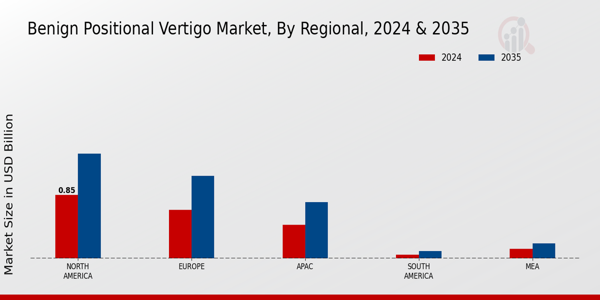Market Growth Projections
The Global Benign Positional Vertigo Market Industry is poised for substantial growth in the coming years. Projections indicate that the market will reach 2.13 USD Billion in 2024, with expectations to expand to 3.5 USD Billion by 2035. This growth trajectory reflects a compound annual growth rate of 4.62% from 2025 to 2035. Factors contributing to this growth include rising awareness of vertigo disorders, advancements in diagnostic technologies, and increased investment in healthcare infrastructure. As the market evolves, stakeholders must remain attuned to emerging trends and patient needs to capitalize on the opportunities presented by this expanding industry.
Growing Awareness and Education
There is a notable increase in awareness and education regarding benign positional vertigo, which serves as a catalyst for the Global Benign Positional Vertigo Market Industry. Public health campaigns and educational programs aimed at both healthcare professionals and the general population have led to improved recognition of symptoms associated with BPPV. This heightened awareness encourages individuals to seek medical advice sooner, thereby increasing the demand for treatment options. As educational initiatives continue to expand, the market is expected to grow at a compound annual growth rate of 4.62% from 2025 to 2035, reflecting a shift towards proactive healthcare management.
Rising Prevalence of Vertigo Disorders
The increasing incidence of vertigo disorders globally is a primary driver for the Global Benign Positional Vertigo Market Industry. As populations age, the prevalence of conditions such as benign paroxysmal positional vertigo (BPPV) rises. In 2024, the market is projected to reach 2.13 USD Billion, reflecting the growing need for effective treatment options. This trend is particularly evident in developed nations where healthcare access allows for better diagnosis and management of vertigo disorders. The aging demographic, coupled with a greater awareness of vestibular disorders, suggests that the market will continue to expand as more individuals seek medical intervention.
Advancements in Diagnostic Technologies
Technological innovations in diagnostic tools are significantly influencing the Global Benign Positional Vertigo Market Industry. Enhanced imaging techniques and vestibular assessments allow for more accurate and timely diagnosis of BPPV. For instance, the introduction of portable diagnostic devices has improved accessibility for patients in remote areas. This advancement not only facilitates early intervention but also contributes to better patient outcomes. As healthcare providers increasingly adopt these technologies, the market is likely to experience growth. The integration of artificial intelligence in diagnostic processes may further streamline operations, potentially increasing the market's value as it approaches 3.5 USD Billion by 2035.
Emergence of Innovative Treatment Options
The emergence of innovative treatment options is reshaping the Global Benign Positional Vertigo Market Industry. New therapeutic approaches, including vestibular rehabilitation therapy and advanced surgical techniques, are being developed to address BPPV more effectively. These innovations are often accompanied by clinical evidence demonstrating their efficacy, which enhances their acceptance among healthcare providers. As patients become more informed about available treatments, the demand for these innovative solutions is expected to rise. This trend may significantly impact market dynamics, potentially driving growth as the industry adapts to meet evolving patient needs.
Increased Investment in Healthcare Infrastructure
Investment in healthcare infrastructure is a crucial driver for the Global Benign Positional Vertigo Market Industry. Governments and private entities are allocating resources to enhance healthcare facilities, particularly in developing regions. This investment leads to improved access to diagnostic and treatment services for vertigo disorders. Enhanced infrastructure not only supports the delivery of care but also fosters research and development in the field. As healthcare systems evolve, the market is likely to benefit from increased patient throughput and improved treatment modalities, contributing to its projected growth to 3.5 USD Billion by 2035.
























